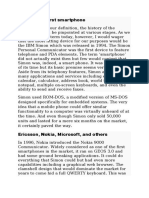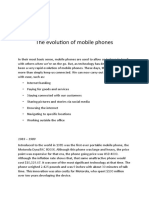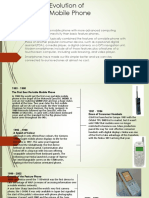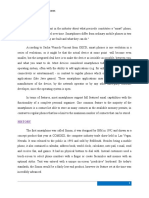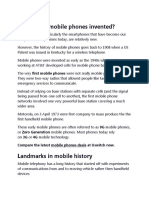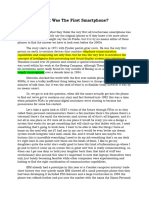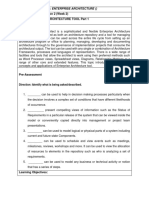The History and Evolution of the Smartphone
The smartphone has become an indispensable part of modern life, but its history is a long
and complex journey, stretching from clunky, futuristic prototypes to the sleek, powerful
computers we carry in our pockets today. The story of the smartphone is not just a tale of
technological innovation, but a narrative of how a single device transformed communication,
commerce, and culture. This document traces the origins, key milestones, and revolutionary
moments that shaped the smartphone as we know it.
Chapter 1: The Early Pioneers and the Dawn of the “Communicator”
The idea of a personal device that combined a phone with a computer was conceived long
before the technology existed to make it a reality. While the first mobile phone call was made
in 1973 by Motorola's Martin Cooper, it would be nearly two decades before the concept of a
"smartphone" began to take shape.
The first true ancestor of the modern smartphone was the IBM Simon Personal
Communicator, which was unveiled as a prototype in 1992 and sold to the public in 1994.
While massive and expensive by today's standards—weighing over a pound and costing
nearly $1,100—the Simon was a marvel of its time. It featured a monochrome LCD
touchscreen that users operated with a stylus, and it came pre-loaded with applications like a
calendar, address book, calculator, and a notepad. Most importantly, it could send and
receive calls, emails, and faxes. Though its commercial success was limited due to its high
price and bulky design, the IBM Simon laid the conceptual groundwork for a device that was
more than just a telephone.
Following the Simon, a new category of devices emerged: the "Communicator." In 1996, Nokia
released the Nokia 9000 Communicator, a device that looked like a conventional phone but
unfolded to reveal a full QWERTY keyboard and a large, wide screen. This device was a
favorite among business professionals for its email and web browsing capabilities, proving
that there was a market for mobile devices that could handle more than just voice calls.
Chapter 2: The Rise of the PDAs and the BlackBerry Era
The late 1990s and early 2000s saw the convergence of two major technological trends: the
evolution of mobile phones and the growing popularity of Personal Digital Assistants (PDAs).
Devices like the Palm Pilot and the Handspring Visor were handheld computers designed for
managing schedules, contacts, and notes, but they lacked cellular connectivity. It was a
natural next step to combine these functionalities.
This period was also marked by the birth of the term "smartphone." In 1997, Ericsson used the
term to describe its GS88 "Penelope" prototype. Although the device never made it to
market, the name stuck. Ericsson later released the R380 in 2000, which was the first device
to be marketed as a "smartphone." It featured a monochrome touchscreen, mobile internet
browsing, and the Symbian operating system.
However, the dominant force in the pre-iPhone smartphone market was Research In Motion
�(RIM) with its BlackBerry series. The BlackBerry, with its iconic physical QWERTY keyboard
and secure email service, became a status symbol for business professionals. Its "push email"
feature, which delivered emails to the device in real-time, was revolutionary. BlackBerry
devices were so essential for corporate communication that they were often referred to as
"CrackBerrys." The success of BlackBerry cemented the idea that a smartphone was primarily
a tool for productivity and communication, heavily reliant on a physical keyboard.
During this era, other key features were introduced that are now taken for granted. In 2000,
Sharp released the J-SH04 in Japan, widely considered the first phone with an integrated
camera. The year 2001 also brought the introduction of 3G networks, which made mobile
internet a practical reality, and the first mobile phones with GPS technology began to appear.
Chapter 3: The iPhone and the Modern Smartphone Revolution
The year 2007 is widely regarded as the most pivotal moment in smartphone history. On
January 9, 2007, Apple CEO Steve Jobs introduced the iPhone, a device that fundamentally
redefined what a smartphone could be. At the time, the market was dominated by devices
with physical keyboards and styluses. The iPhone's revolutionary design—a large, multi-touch
capacitive screen that a user could control with their fingers—was a radical departure.
The iPhone was not just a hardware innovation; its software was equally groundbreaking. The
iPhone's operating system (initially called iPhone OS, now iOS) was built on a robust Unix-
based platform and featured a simple, elegant, and intuitive user interface. It seamlessly
integrated the functions of a phone, an iPod, and an internet communicator. It also pioneered
the "pinch-to-zoom" gesture and introduced an accelerometer, allowing the screen
orientation to change when the phone was rotated.
The real game-changer, however, came a year later with the launch of the App Store in July
2008. The App Store created an ecosystem where third-party developers could create and
sell applications, turning the iPhone into a customizable, multifunctional platform. This shift
from a device with a fixed set of features to a device defined by its applications was the spark
that ignited the modern smartphone era.
Chapter 4: The Rise of Android and the App-Driven Ecosystem
The iPhone’s success did not go unnoticed. Google, which had been developing its own
mobile operating system, quickly shifted its focus to compete. In 2008, a year after the
iPhone's debut, the first commercially available Android phone, the T-Mobile G1 (also known
as the HTC Dream), was released.
Android’s strategy was to be an open-source platform, allowing various manufacturers (such
as Samsung, HTC, Motorola, and later countless others) to build their own devices. This
approach led to a rapid proliferation of Android phones at a wide range of price points,
making smartphones accessible to a much broader global audience than the premium-priced
iPhone. The rivalry between Apple's iOS and Google's Android has been the primary driver of
innovation in the mobile industry ever since.
Both platforms rapidly evolved, adding key features that we now take for granted. The
�Android Market (later rebranded as the Google Play Store) was launched to compete with the
App Store. Multitasking, improved notification systems, and enhanced camera technologies
were introduced. This intense competition led to rapid advancements in hardware, from
higher-resolution displays and more powerful processors to better battery life and integrated
GPS.
The App Store and the Google Play Store transformed the smartphone from a communication
tool into a personal hub for entertainment, productivity, education, and social media. The
"App Economy" created new industries and fundamentally changed how people interact with
services, from ordering food to hailing a ride.
Chapter 5: The Modern Smartphone and the Future
In the years following the initial iPhone and Android boom, the smartphone continued to
mature. The focus shifted from adding entirely new features to refining existing ones. The
screens got bigger and sharper, the cameras became powerful enough to rival professional
equipment, and biometric security like fingerprint scanners and facial recognition became
standard.
The transition to 4G and then 5G networks enabled a mobile experience that was faster and
more seamless than ever before, paving the way for high-quality video streaming, augmented
reality (AR), and sophisticated cloud-based applications. AI and machine learning have also
been integrated into every aspect of the smartphone, powering voice assistants like Siri and
Google Assistant, improving predictive text, and enhancing photo processing.
Today, the smartphone is more than just a phone; it is a portable computer, a camera, a video
game console, a navigation system, a mobile wallet, and a key to accessing the digital world.
The journey from the bulky IBM Simon to the sleek, glass-and-metal slabs of today's market is
a testament to relentless innovation and a testament to the profound impact technology can
have on society. As new technologies like foldable screens and advanced AI continue to
emerge, the story of the smartphone is far from over.












